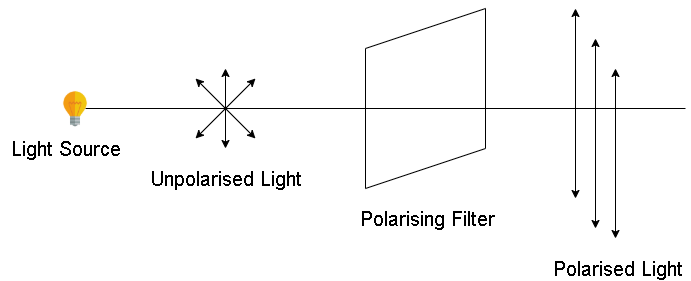
What is the polarization of light?
Answer
508.7k+ views
Hint: Polarisation of light is a property shown by transverse waves. The light waves which travel only in a single plane are known as polarized light waves. The process of transforming unpolarized light waves to polarized light waves is called the polarisation of light.
Complete step by step answer:
Step I:
Light waves are electromagnetic waves that can travel in all directions. These light waves are produced by the vibration of electric charges. Consider that light waves are transverse in nature. A transverse wave has both electric as well as magnetic components both.
Step II:
The electric and magnetic waves are perpendicular to each other. So one plane is occupied by an electric field and the other by the magnetic field. These vibrations can occur in a number of directions. The light wave that is vibrating in only one plane is called unpolarized light.

Step III:
The polarisation of light can be done by restricting the electric vector components of the wave only in one plane by filtration with respect to the direction of propagation. Infiltration, the light waves that are vibrating in the same plane are absorbed, while those traveling in a perpendicular direction left unabsorbed. All the other waves vibrate in the same plane.
Note:
Polarisation is an important property of light. The polarization of light helps in determining the nature of the light rays. The degree of polarization depends on the angle of incidence of light. The degree of polarization varies inversely with the angles of an incident of light. As the incident angles of light decreases, the polarization of the light increases.
Complete step by step answer:
Step I:
Light waves are electromagnetic waves that can travel in all directions. These light waves are produced by the vibration of electric charges. Consider that light waves are transverse in nature. A transverse wave has both electric as well as magnetic components both.
Step II:
The electric and magnetic waves are perpendicular to each other. So one plane is occupied by an electric field and the other by the magnetic field. These vibrations can occur in a number of directions. The light wave that is vibrating in only one plane is called unpolarized light.

Step III:
The polarisation of light can be done by restricting the electric vector components of the wave only in one plane by filtration with respect to the direction of propagation. Infiltration, the light waves that are vibrating in the same plane are absorbed, while those traveling in a perpendicular direction left unabsorbed. All the other waves vibrate in the same plane.
Note:
Polarisation is an important property of light. The polarization of light helps in determining the nature of the light rays. The degree of polarization depends on the angle of incidence of light. The degree of polarization varies inversely with the angles of an incident of light. As the incident angles of light decreases, the polarization of the light increases.
Recently Updated Pages
Master Class 12 English: Engaging Questions & Answers for Success

Master Class 12 Business Studies: Engaging Questions & Answers for Success

Master Class 12 Economics: Engaging Questions & Answers for Success

Master Class 12 Social Science: Engaging Questions & Answers for Success

Master Class 12 Maths: Engaging Questions & Answers for Success

Master Class 12 Chemistry: Engaging Questions & Answers for Success

Trending doubts
What are the major means of transport Explain each class 12 social science CBSE

Which are the Top 10 Largest Countries of the World?

Draw a labelled sketch of the human eye class 12 physics CBSE

Explain sex determination in humans with line diag class 12 biology CBSE

The pH of the pancreatic juice is A 64 B 86 C 120 D class 12 biology CBSE

Explain sex determination in humans with the help of class 12 biology CBSE




